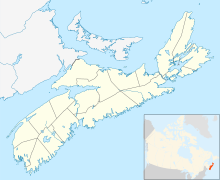Old Burying Ground (Halifax, Nova Scotia)

|
|
| Nova Scotia | |
| Details | |
|---|---|
| Established | 1749 |
| Location | Halifax, Nova Scotia |
| Country | Canada |
| Coordinates | 44°38′36″N 63°34′22″W / 44.6434°N 63.5728°WCoordinates: 44°38′36″N 63°34′22″W / 44.6434°N 63.5728°W |
| Type | Closed |
| Owned by | St. Paul's Church (Halifax) |
| Number of graves | 12,000+ |
| Official name | Old Burying Ground National Historic Site of Canada |
| Designated | 1991 |
| Type | Provincially Registered Property |
| Designated | 1988 |
The Old Burying Ground (also known as St. Paul's Church Cemetery) is a historic cemetery in Halifax, Nova Scotia, Canada. It is located at the intersection of Barrington Street and Spring Garden Road in Downtown Halifax.
The Old Burying Ground was founded in 1749, the same year as the settlement, as the town's first burial ground. It was originally non-denominational and for several decades was the only burial place for all Haligonians. (The burial ground was also used by St. Matthew's United Church (Halifax).) In 1793 it was turned over to the Anglican St. Paul's Church. The cemetery was closed in 1844 and the Camp Hill Cemetery established for subsequent burials. The site steadily declined until the 1980s when it was restored and refurbished by the Old Burying Ground Foundation, which now maintains the site and employ tour guides to interpret the site in the summer. Ongoing restoration of the rare 18th century grave markers continues.
Over the decades some 12,000 people were interred in the Old Burial Ground. Today there are only some 1,200 headstones, some having been lost and many others being buried with no headstone. Many notable residents are buried in the cemetery, including British Major General Robert Ross, who led the successful Washington Raid of 1814 and burned the White House before being killed in battle at Baltimore a few days later.
The most prominent structure is the Welsford-Parker Monument, a Triumphal arch standing at the entrance to the cemetery commemorating British victory in the Crimean War. This is the second oldest war monument in Canada and the only monument to the Crimean War in North America. The arch was built in 1860, 16 years after the cemetery had officially closed. The arch was built by George Lang and is named after two Haligonians, Major Augustus Frederick Welsford and Captain William Buck Carthew Augustus Parker. Both Nova Scotians died in the Battle of the Great Redan during the Siege of Sevastopol (1854–1855). This monument was the last grave marker in the cemetery.
...
Wikipedia

